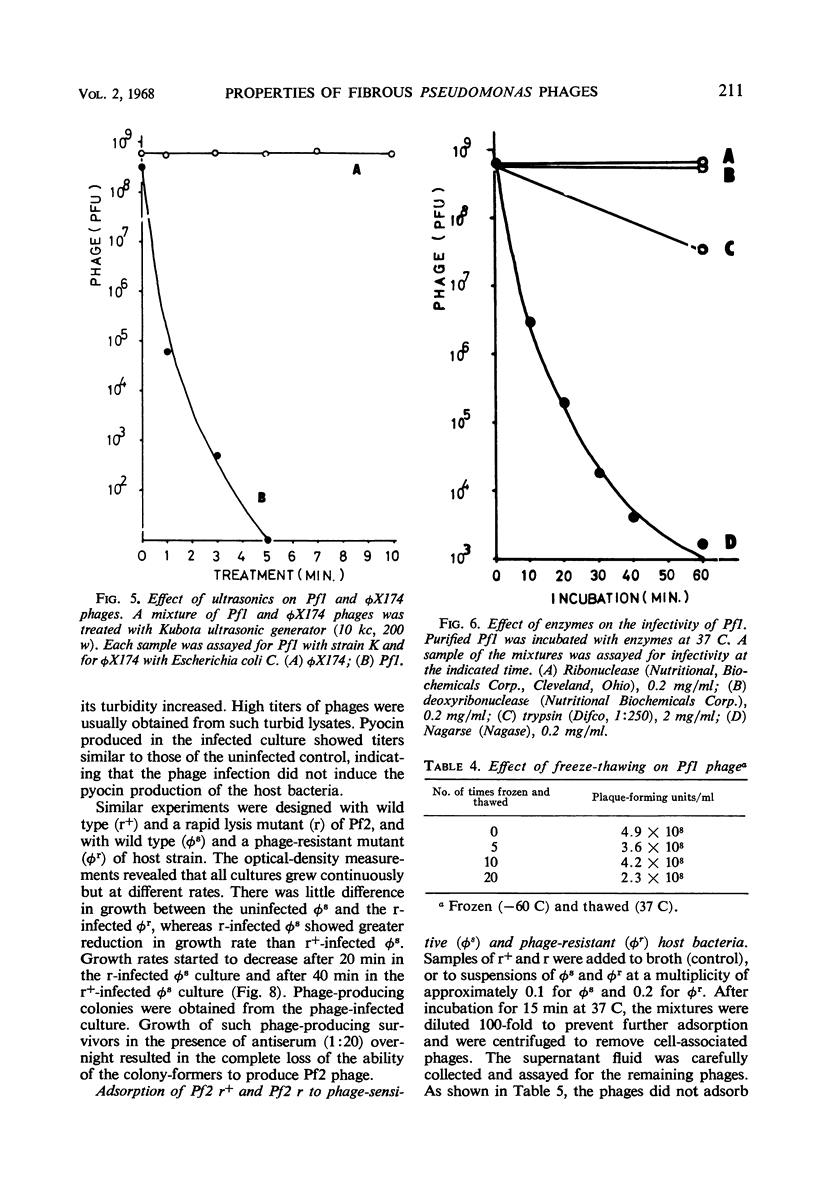Abstract
Two fibrous Pseudomonas phages, Pf1 and Pf2, have been isolated and characterized. The phages were serologically related and were indistinguishable morphologically when viewed by electron microscopy. Both phages formed minute turbid plaques. A simple method was devised for easy differentiation of such plaques from the bacterial lawn. The infected bacteria continued to grow and to liberate the phages into the medium. The phages were collected from the turbid “lysate” by salting out and were purified by differential centrifugation and density gradient centrifugation. The purified phages were sensitive to ultrasonics and to a proteolytic enzyme, Nagarse. A rapid lysis mutant was obtained from the progeny of plaquepurified Pf2. Pf2 was spontaneously produced by strain P28 of P. aeruginosa. Neither acridine orange nor antiserum affected the phage-producing capacity of the bacteria.
Full text
PDF





Images in this article
Selected References
These references are in PubMed. This may not be the complete list of references from this article.
- Caro L. G., Schnös M. The attachment of the male-specific bacteriophage F1 to sensitive strains of Escherichia coli. Proc Natl Acad Sci U S A. 1966 Jul;56(1):126–132. doi: 10.1073/pnas.56.1.126. [DOI] [PMC free article] [PubMed] [Google Scholar]
- Hirota Y. THE EFFECT OF ACRIDINE DYES ON MATING TYPE FACTORS IN ESCHERICHIA COLI. Proc Natl Acad Sci U S A. 1960 Jan;46(1):57–64. doi: 10.1073/pnas.46.1.57. [DOI] [PMC free article] [PubMed] [Google Scholar]
- Hoffmann-Berling H., Kaerner H. C., Knippers R. Small bacteriophages. Adv Virus Res. 1966;12:329–370. doi: 10.1016/s0065-3527(08)60852-0. [DOI] [PubMed] [Google Scholar]
- Ishii S. I., Nishi Y., Egami F. The fine structure of a pyocin. J Mol Biol. 1965 Sep;13(2):428–431. doi: 10.1016/s0022-2836(65)80107-3. [DOI] [PubMed] [Google Scholar]
- Takeya K., Amako K. A rod-shaped Pseudomonas phage. Virology. 1966 Jan;28(1):163–165. doi: 10.1016/0042-6822(66)90317-5. [DOI] [PubMed] [Google Scholar]
- Takeya K., Minamishima Y., Amako K., Ohnishi Y. A small rod-shaped pyocin. Virology. 1967 Jan;31(1):166–168. doi: 10.1016/0042-6822(67)90021-9. [DOI] [PubMed] [Google Scholar]
- VAN ASPEREN K. Mode of action of organophosphorus insecticides. Nature. 1958 Feb 1;181(4605):355–356. doi: 10.1038/181355a0. [DOI] [PubMed] [Google Scholar]





